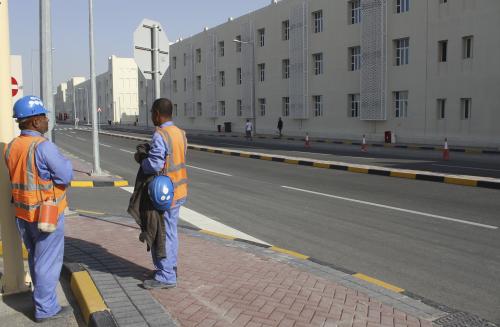For centuries, people and merchandise have traversed the Indian Ocean, giving life to economic and cultural exchanges between the people of the East African Coast and the Gulf. This set in motion inter-cultural encounters and the formation of diaspora communities. Fast forward to today, and a considerable portion of the Middle East’s surging migrant population consists of workers from Asia and Africa travelling to oil-rich Persian Gulf countries. This includes Kenyans, for whom migration to the Gulf—especially to Saudi Arabia, the United Arab Emirates (UAE), and Qatar—is trending upwards.
Kenya represents a new source of inexpensive and well-educated labor for these countries. As of 2014, Kenyan authorities estimated there were 100,000 migrant workers in the region, and Gulf countries are once again pivoting to East Africa for economic and geopolitical reasons. For Kenyans, unemployment at home, the difficulty of gaining entry to western countries, combined with the economic growth and proximity of the Gulf, have attracted migrants. Semi- and low-skilled workers have dominated Kenyan migration to the Gulf, with many being recruited as domestic workers, construction laborers, and hospitality servers.
Given the 2015 bilateral deal signed by Kenya and the UAE to recruit 100,000 Kenyans for jobs, and a similar deal being negotiated with Saudi Arabia, Kenyan migrant flows to the Middle East are set to increase. There are concerns that such deals prioritize national economic interests at the expense of individual human rights. Kenya can show other countries in sub-Saharan Africa how to best manage these tradeoffs.
Counting the cost
Overall, Kenya’s economy is doing well, with growth accelerating for the third consecutive year to an estimated 5.9 percent in 2016, in contrast to the general slump in sub-Saharan Africa, whereby region wide growth was just 1.5 percent last year. However, poverty remains pervasive, with 22.9 percent of Kenya’s population living in extreme poverty. Job creation has not kept pace with population growth: from 2009 to 2013, Kenya’s working-age population increased by 3 million, but fewer than 2.6 million jobs were created, almost 90 percent of which were in the informal economy. Case in point: from the early morning hours, groups of unemployed women wait by the roadside in many Nairobi suburbs in the hope of finding domestic work—an industry plagued by a lack of protection both in Kenya and abroad. With unemployment high at home, many search abroad for work.
The exodus is not just about unemployment. For many Kenyan migrants, especially the more skilled workers, the Gulf affords access to greater professional and educational opportunities, as well as much higher wages. And governments also like the remittances generated as a result of emigration. In 2015, Kenyan migrants earned $1.6 billion, equivalent to approximately 3 percent of GDP, making the country among the top 10 remittance recipient countries worldwide. Recognizing this economic force, the government has adopted a ‘Diaspora Policy’ to leverage the resources and skills of Kenyans abroad.
Foreign workers, especially from developing countries, make up a large majority of the Gulf’s labor force (the figure is 88 percent in the UAE, for example); financial flows from the region are significant and represent a positive effect for home countries. However, the International Organization for Migration recently identified routes of migration and trafficking to the Middle East that make Kenyans vulnerable to exploitation.
Like their Asian counterparts, the woes of Kenyan domestic workers include unpaid wages, long working hours, passport confiscation, and physical and sexual abuse. In light of growing media coverage of such abuses and criticism of its lack of oversight and protection, the Kenyan government revoked the licenses of hundreds of recruiting agencies in 2014 and banned Kenyans migrating to the Gulf for domestic work.
But these bans are not always effective, as unscrupulous recruiters instead route migrants through unregulated channels or turn to countries with fewer protections. According to the nongovernmental organization Trace Kenya, there may be approximately 300,000 Kenyans working in the Middle East, one third of whom have been trafficked. Recruiters turned to Kenya when countries in Asia barred such recruitments, and now Saudi Arabia has reportedly started recruiting from Somalia.
The Kenyan government can do much more to protect its citizens abroad. A report by Haki Africa implicating some government officials in the illegal recruitment of workers to the Middle East is hardly encouraging, and highlights that the tentacles of corruption can lock hapless Kenyans into uncompensated servitude.
What next?
It is an election year in Kenya. Beyond tribal politics, corruption and the mismanagement of public resources, the rising cost of living, as well as unemployment will all be high on the agenda. Looking forward, by 2030, Kenya’s working-age population is projected to grow to 39.2 million from the current 25.5 million. This will do little to stem the flow of Kenyan migrants looking for greener pastures overseas. As much as Gulf countries are criticized for their labor-rights records, the Kenyan government must also fulfill its responsibilities—not only to protect their citizens abroad, but also to make things better at home by creating an investment climate that leads to productive jobs for youth, and helping to increase the productivity of the 80 percent of workers employed in the vast informal sector.
Where ivory and fine silks once flowed through the dhow trade, today, different materials are traded—but the movement of goods and people has continued. Kenyans ought to be able to count on good governance to anchor their future prospects.
The Brookings Institution is committed to quality, independence, and impact.
We are supported by a diverse array of funders. In line with our values and policies, each Brookings publication represents the sole views of its author(s).







Commentary
No win-wins in Kenya’s modern-day voyages in search of work
May 26, 2017